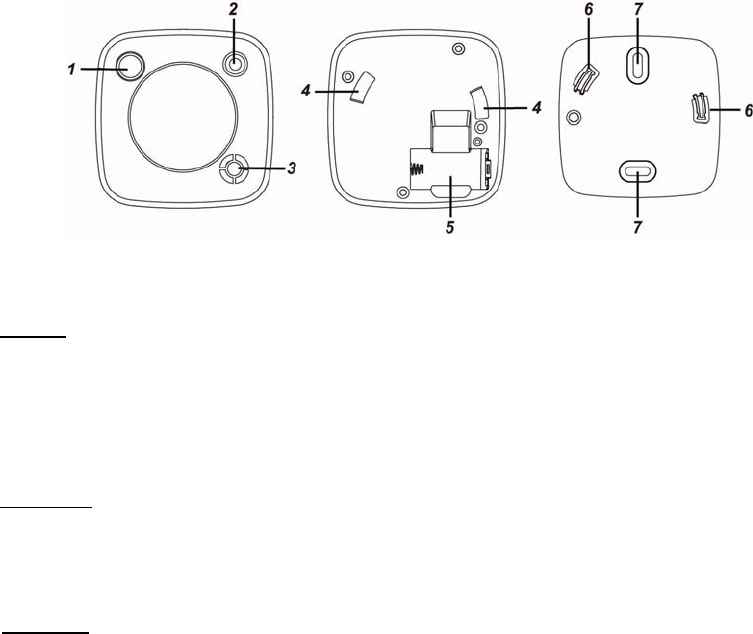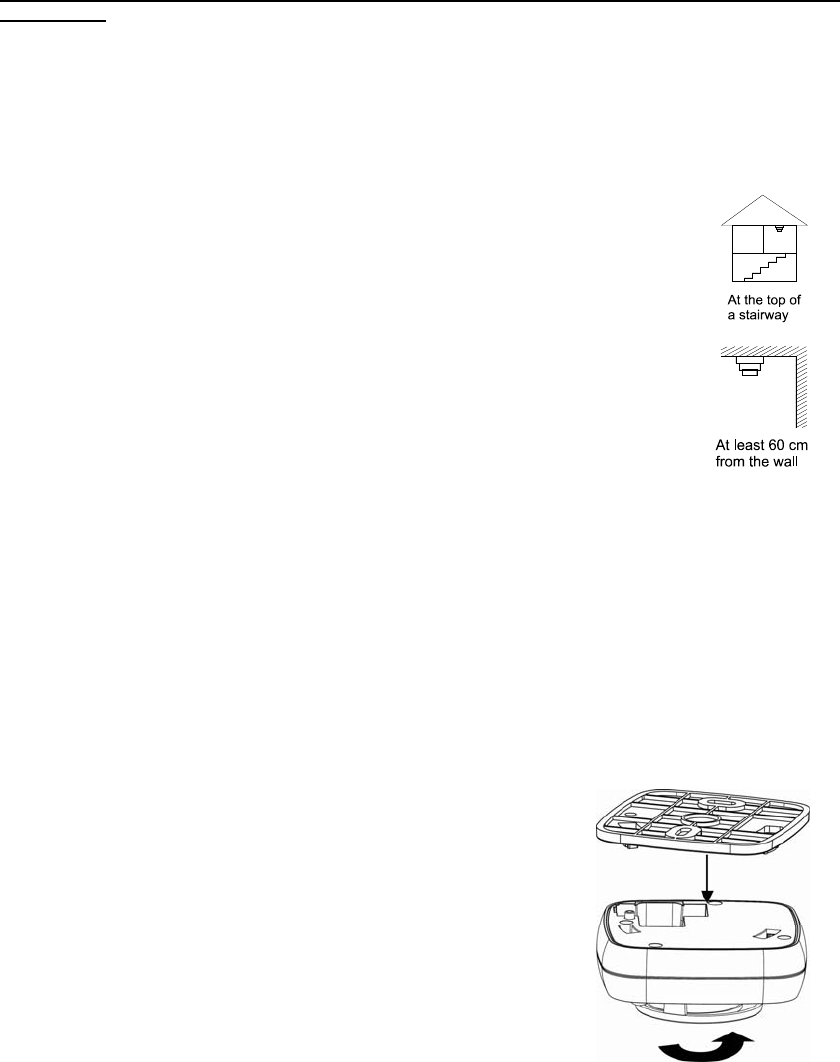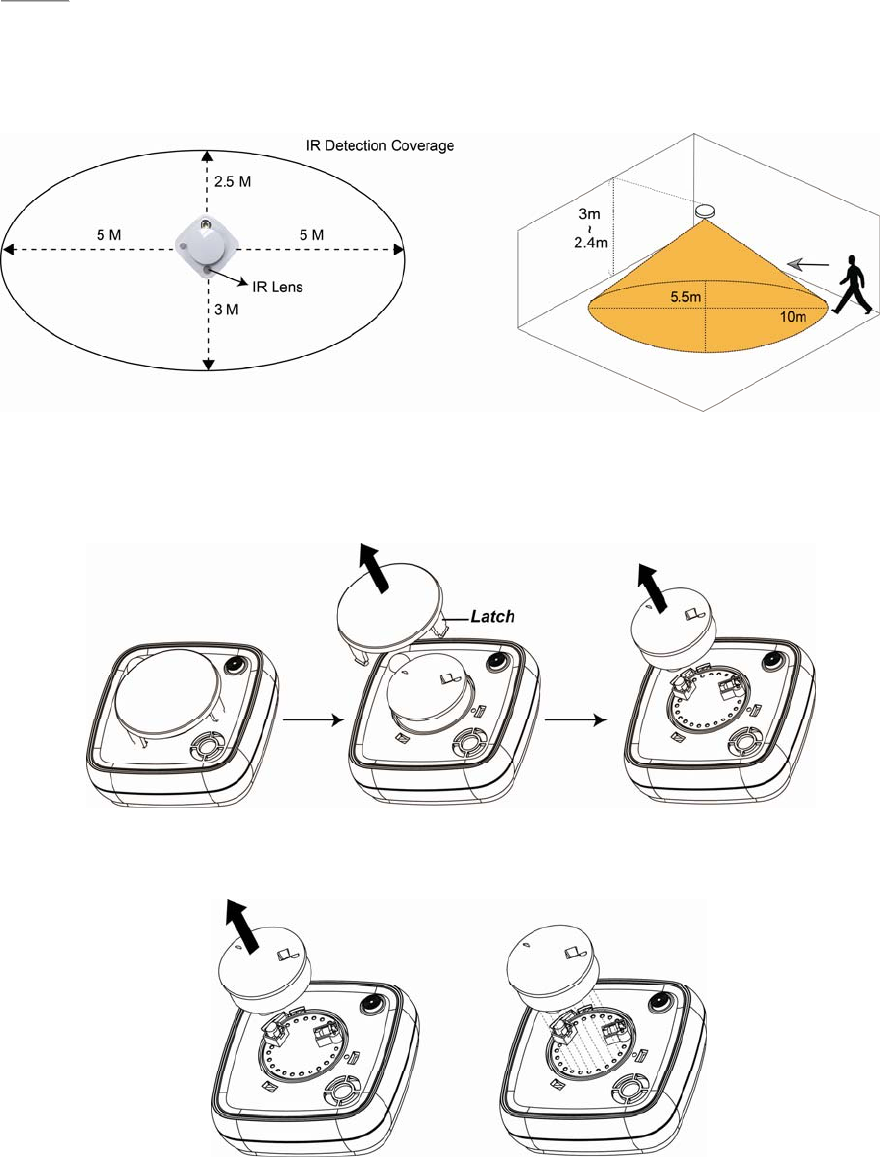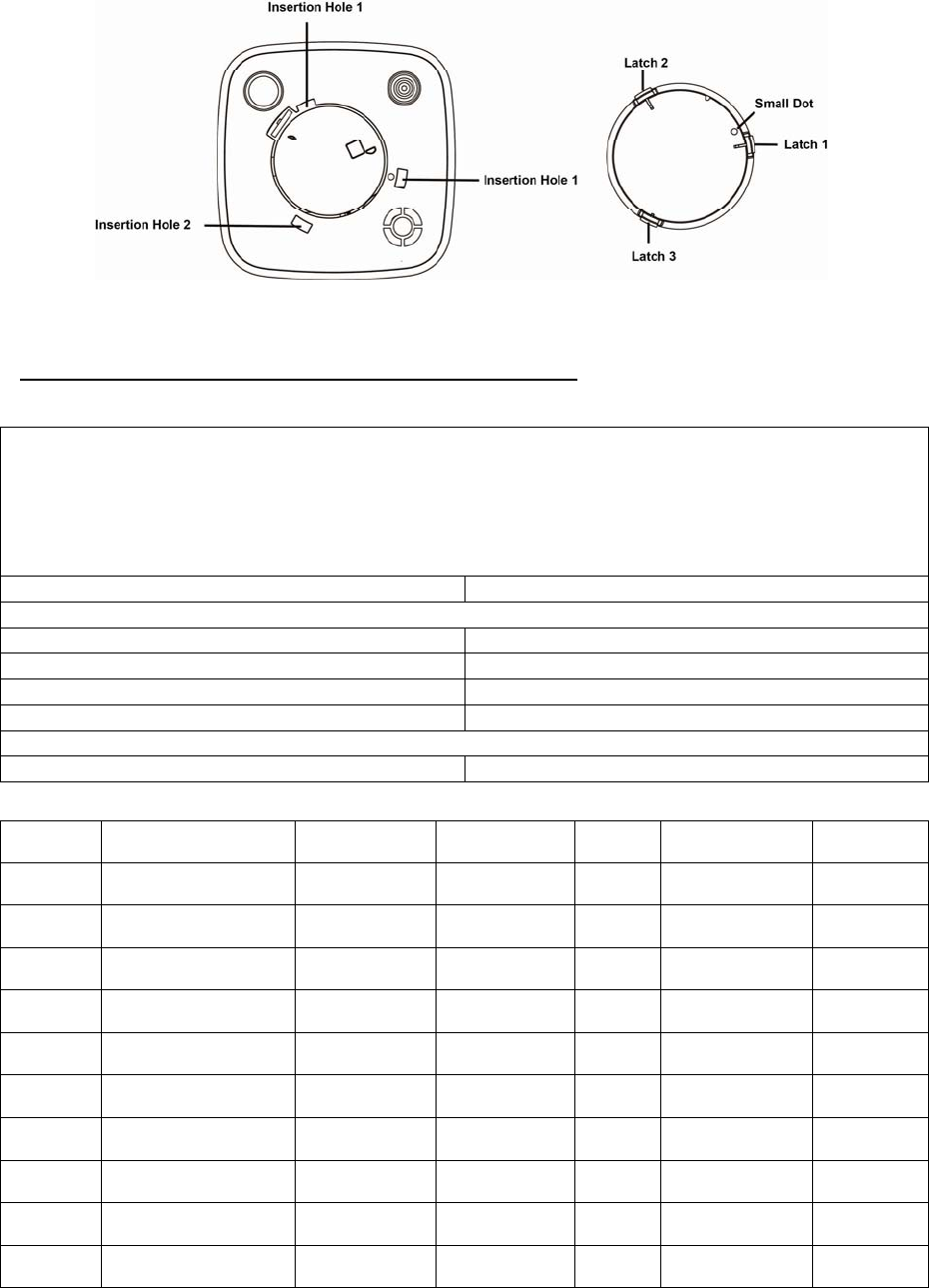Climax Technology Co MISD Mini Smoke Detector User Manual Mini SD TM ZBS 20160517
Climax Technology Co Ltd Mini Smoke Detector Mini SD TM ZBS 20160517
Users Manual

M
Mi
in
ni
i
S
SD
D-
-T
TM
M
Z
ZB
BS
S
M
Mi
in
ni
i
S
Sm
mo
ok
ke
e
D
De
et
te
ec
ct
to
or
r
Mini SD-TM-ZBS Mini Smoke Detector is a ZigBee Smoke Detector with built-in PIR and Temperature sensor, it is capable
of sending wireless signals to the coordinator in the ZigBee network upon detection of smoke particles or abnormal high
heat to protect house from fire hazards. The Mini Smoke Detector’s alarm situations, battery condition, operating conditions,
supervisory data and general fault information are sent to the ZigBee Control Panel wirelessly.
The Mini Smoke Detector also features IR detection. The it detects infrared signature to pick up movements within an
assigned area and signals the Control Panel to activate the alarm if an intruder crosses its’ path of detection.
The Mini Smoke Detector utilizes ZigBee technology for wireless signal transmission. ZigBee is a wireless communication
protocol that is reliable and has low power consumption and high transmission efficiency. Based on IEEE802.15.4 standard,
ZigBee allows a large amount of devices to be included in a network and coordinated for data exchange and signal
transmission.
The Mini Smoke Detector serves as an end device in the ZigBee network. It can be included in the ZigBee network to
transmit signal upon activation, but cannot permit any other ZigBee device to join the network through the Mini Smoke
Detector.
P
Pa
ar
rt
ts
s
I
Id
de
en
nt
ti
if
fi
ic
ca
at
ti
io
on
n
1. IR lens
2. LED Indicator / Test Button
Red LED
Turns ON briefly: Transmitting signal.
Quick flash: Alarming.
Flashes every 2 seconds: Mini Smoke Detector under warmup and calibration process.
Flashes every 1 second: Mini Smoke Detector under Sleep Mode
Flashes every 4 seconds: battery exhausted.
Flashes once every 20 minutes: the Mini Smoke Detector has lost connection to its current ZigBee network.
Orange LED
Flash every second: Device power on/Calibration failed.
Flashes every 5 seconds: Detecting smoke failed or device malfunctioning.
Flashes every 4 seconds: battery exhausted.
Flashes every 45 seconds: Low battery condition
Test Button
Press and hold the button for 10 seconds then release to reset the Mini Smoke Detector.
Press and hold the button for 20 seconds to enter calibration process.
Press the button once to send a supervision signal/test Mini Smoke Detector
Transmit a radio signal for testing the radio communication range.
Test if the Mini Smoke Detector is functioning normally.
Silence the Mini Smoke Detector’s alarm.
3. Buzzer
4. Mounting Holes (for Hooks)
The Hooks of the Mounting Bracket can hook into this Mounting Hole.
5. Battery compartment
6. Hooks
7. Mounting Holes

Features
B
Ba
at
tt
te
er
ry
y
A 3V CR123A Lithium Battery is used to supply power to the Mini Smoke Detector.
The Smoke Detector has a foolproof mechanism which prohibits cover closure without first installing battery.
When the Mini Smoke Detector is low on battery, a low battery signal will be transmitted along with regular
signal transmissions. The Orange LED will flash with accompanying low-volume beep once every 45
seconds.
The Red and Orange LED will flash once every 4 seconds when the battery is exhausted.
<
<N
NO
OT
TE
E>
>
When changing the battery, after removing the old battery, press the Test Button twice to fully discharge
before inserting new battery.
T
Te
es
st
ti
in
ng
g
t
th
he
e
M
Mi
in
ni
i
S
Sm
mo
ok
ke
e
D
De
et
te
ec
ct
to
or
r
By pressing the Test Button on the Mini Smoke Detector, you can test if the Mini Smoke Detector is functioning
normally.
If the Mini Smoke Detector functions normally, the Red LED will be on for 2 seconds followed by a 2-tone
beep.
If the buzzer sounds 2-tone beeps 3 times, the “Optical Chamber” on the Mini Smoke Detector is either dirty
or out-of-order.
If the Red LED doesn’t light and no beep is sounded, it means the Mini Smoke Detector is out-of-order.
S
Sl
le
ee
ep
p
T
Ti
im
me
er
r
The Mini Smoke Detector has a “sleep time” of approximately 1 minute to conserve power. After 1 minute any
detected movement will be transmitted.
T
Te
es
st
t
M
Mo
od
de
e
The Mini Smoke Detector can be put into Test mode by pressing the Test Button. In Test mode, it will disable the
sleep timer and will enable the LED indicator to flash every time a movement is detected. Every time the Test
Button is pressed, the Mini Smoke Detector will transmit a test signal to the Control Panel for radio range test
and enter the test mode for 3 mins. It will exit Test Mode automatically after 3 minutes and return to normal
mode.
S
Su
up
pe
er
rv
vi
is
si
io
on
n
The Mini Smoke Detector will transmit a supervision signal to report its condition regularly according to user
setting. The factory default interval is 30 minutes. The user can also press the Test Button once to transmit a
supervision signal manually.
T
Te
em
mp
pe
er
ra
at
tu
ur
re
e
D
De
et
te
ec
ct
ti
io
on
n
The Temperature Sensor will transmit temperature signals regularly according to setting. The factory default
interval is 10 minutes.
The Mini Smoke Detector will also send temperature signal when temperature changes by +/- 2°C.
You can also press the Test Button once to transmit a temperature signal manually.
The temperature detection range is about -10°C ~ 50°C.( 14°F ~ 122°F)
A
Al
la
ar
rm
m
D
De
et
te
ec
ct
ti
io
on
n
The Mini Smoke Detector will activate fire alarm when either of its smoke detection or high heat detection function
is triggered. When an alarm is activated, the Mini Smoke Detector will transmit alarm signal and raise alarm with
its built in buzzer, the Red LED will flash rapidly. The alarm sound will repeat in pattern of 3-second alarm and
1-second pause.
Smoke Detection:
The Alarm is activated whenever the smoke concentration exceeds the detection threshold.
The Mini Smoke Detector will check some concentration every 8 seconds, the alarm will continue until the
smoke concentration drops below alarm threshold.
Heat Detection:
Rate of Rise: When the temperature rises by 8.25°C per minute.
High Heat: When the temperature exceeds 57.3°C
The Mini Smoke Detector will check temperature every 10 seconds. It will only stop alarming if the temperature
drops below alarm threshold:
If the alarm was triggered by Rate of Rise condition (8.25°C per minute or more): The temperature must drop
to 4°C below highest temperature detected for the Detector to stop alarming.
If the alarm was triggered by High Heat condition (57.3°C): The temperature must drop below 49°C for Mini
Smoke Detector to stop alarming.
For both Smoke alarm and Heat Alarm, a restore signal will be transmitted if no smoke is detected again for
160 seconds.
IR Detection:
The Mini Smoke Detector will only transmit burglar alarm signal to the Control Panel if any movement is

picked up within the IR detection coverage, the buzzer will not sound and the LED will not flash. (Please
refer to your Control Panel for details).
A
Al
la
ar
rm
m
S
Si
il
le
en
nc
ce
e
After alarm activation, the Mini Smoke Detector can be silenced temporarily by pressing the button.
1. If the button is pressed within 1 minute after alarm activation, the alarm will be silenced 1 minute after
button press. E.g. If the button is pressed 30 seconds after alarm activation, then the alarm will be
silenced at 1 minute and 30 seconds after alarm trigger.
2. If the button is pressed when the alarm has been activated for more than 1 minute, the alarm silenced
immediately and will enter Alarm Silence mode for 9 minutes.
The Alarm Silence mode lasts 9 minutes, the Red LED will flash every second during this period.
During the Alarm Silence period, f the smoke concentration or temperature continue to rise, the Mini Smoke
Detector will sound the alarm again and cannot be silenced by button press. The alarm condition must
subside for the alarm to stop
When the 9-minute Alarm Silence period expires:
If the smoke concentration or temperature has dropped below alarm threshold, the Mini Smoke Detector will
sound a 2-tone beep and, transmits an alarm restore signal and returns to normal operation mode.
If the smoke concentration or temperature is still above alarm threshold, the Mini Smoke Detector will sound
the alarm again.
R
Re
ec
ca
al
li
ib
br
ra
at
ti
io
on
n
As the operation condition of the Mini Smoke Detector may vary after being installed for some time, you may wish
to recalibrate the Mini Smoke Detector to take a new smoke detection threshold value and ensure optimal
performance of the Mini Smoke Detector. To do this:
Press 20 seconds on the Test Button and hold until the Red LED starts to flash. The Mini Smoke Detector
will sound 3 short beeps then follow the calibration process to take the new reference value with the Red
LED will flash every 2 seconds to indicate.
If calibration fails, the Mini Smoke Detector will continuously beep with Orange LED flashing every second,
you need to remove the battery, press the Test Button twice to fully discharge the battery, then reinsert the
batteries to restart Mini Smoke Detector.
Every time the battery is removed and reinserted, the Mini Smoke Detector will also take the new threshold
value following the warming and calibration process.
A
Au
ut
to
o-
-C
Ca
al
li
ib
br
ra
at
ti
io
on
n
The Mini Smoke Detector will perform auto-calibration whenever temperature changes by +/- 5°C. The Mini
Smoke Detector does not give any visual or audio indication during auto-calibration process.
ZigBee Network Setup
Z
Zi
ig
gB
Be
ee
e
D
De
ev
vi
ic
ce
e
G
Gu
ui
id
de
el
li
in
ne
e
ZigBee is a wireless communication protocol that is reliable and has low power consumption and high transmission
efficiency. Based on the IEEE802.15.4 standard, ZigBee allows a large amount of devices to be included in a network
and coordinated for data exchange and signal transmission.
Due to the fundamental structure of ZigBee network, ZigBee device will actively seek and join network after powering
on. Since performing a task in connecting network may consume some power, it is required to follow the instructions to
avoid draining battery of a ZigBee device
- Ensure your ZigBee network router or coordinator is powered on before inserting battery into the ZigBee device.
- Ensure the ZigBee network router or coordinator is powered on and within range while a ZigBee device is in use.
- Do not remove a ZigBee device from the ZigBee network router or coordinator without removing the battery from a
ZigBee device.
J
Jo
oi
in
ni
in
ng
g
t
th
he
e
Z
Zi
ig
gB
Be
ee
e
N
Ne
et
tw
wo
or
rk
k
As a ZigBee device, the Mini Smoke Detector needs to join a ZigBee network to transmit signal when smoke
concentration or temperature is detected. Please follow the steps bellow to join the Mini Smoke Detector into ZigBee
network.
The Mini Smoke Detector has 3 ZigBee Endpoints for PIR, Smoke Detector and Temperature Sensor function. When
joining ZigBee network, it will be recognized as 3 separate ZigBee devices and will occupy 3 zones in your ZigBee
network coordinator.
1. Insert the battery into the battery compartment to power on the Mini Smoke Detector.
2. The Mini Smoke Detector will emit 2 short beeps, and begin warm up for 1 minute, LED flashes every 2 seconds.
3. After 1-minute warm up period expires, the Mini Smoke Detector will emit a beep to indicate it now enters calibration
process. The calibration process takes 1~7 minutes; the LED will continue to flash during calibration.
Joining ZigBee network is prohibited during warm up and calibration process. After calibration process the Mini
Smoke Detector will emit a 2-tone beep, LED will turn off.
4. The Mini Smoke Detector is only available for joining the ZigBee network after completing calibration.
Press and hold the Test Button for 10 seconds and release to search for existing ZigBee network. Please make sure

the permit-to-join feature on the router or coordinator of your ZigBee network is enabled.
5. After joining the ZigBee network, the Mini Smoke Detector will be registered in the network automatically. Please
check the ZigBee coordinator, security system control panel or CIE (Control and Indicating Equipment) to confirm if
joining and registration is successful.
6. When calibration is complete, the Mini Smoke Detector will emit 2 beeps and LED will stop flashing to indicate it is
now under normal operation. If calibration fails, the Mini Smoke Detector will sound continuous beep.
7. Under normal operation, if the Mini Smoke Detector loses connection to its current ZigBee network, the LED
indicator will flash every 20 minutes to indicate the situation. Please check your ZigBee network condition and Mini
Smoke Detector signal range to correct the situation.
R
Re
em
mo
ov
vi
in
ng
g
D
De
ev
vi
ic
ce
e
f
fr
ro
om
m
Z
Zi
ig
gB
Be
ee
e
N
Ne
et
tw
wo
or
rk
k
(
(F
Fa
ac
ct
to
or
ry
y
R
Re
es
se
et
t)
)
To remove the Mini Smoke Detector from current ZigBee network, the Mini Smoke Detector must be put
to Factory Reset to complete device removal. Factory Reset function will clear the device of its stored
setting information and prompt the device to search for new ZigBee network.
Before removing device, make sure the Mini Smoke Detector is within current ZigBee network
signal range
1. Press and hold the function button for 10 seconds, then release the button to reset Mini Smoke
Detector.
2. Upon reset, the device will clear current ZigBee network setting and transmit signal to ZigBee
coordinator to remove itself from current ZigBee network. It will then actively search for available
ZigBee network again and join the network automatically.
Installation
I
In
ns
st
ta
al
ll
la
at
ti
io
on
n
G
Gu
ui
id
de
el
li
in
ne
e
It is recommended that the installation site be in the center area of the ceiling.
Do not locate the detector in the following locations:
The Kitchen – Smoke from cooking might cause an unwanted alarm.
Near a ventilating fan, florescent lamp or air-conditioning equipment – air drafts from
them may affect the sensitivity of the detector.
Near ceiling beams or over a cabinet – stagnant air in these areas may affect the
sensitivity of the detector.
In the peak of an “A” frame type of ceiling.
I
In
ns
st
ta
al
ll
la
at
ti
io
on
n
R
Re
ec
co
om
mm
me
en
nd
da
at
ti
io
on
n
It is recommended to install the Mini Smoke Detector in the following locations.
In a ceiling area with full view of its detection coverage unobstructed by appliances and furniture.
Near the entrance of a room or house to monitor entry activity.
Limitations
Do not install the Mini Smoke Detector exposed to direct sunlight.
Avoid installing the Mini Smoke Detector in areas where devices may cause rapid change of temperature
in the detection area, i.e. air conditioner, heaters, etc.
Avoid large obstacles in the detection area.
Do not pointing directly at sources of heat e.g. Fires or boilers, and not above radiators.
Avoid moving objects in the detection area i.e. curtain, wall hanging etc.
Press the Test Button to enter Test Mode. Walk around the protected area noting when the LED lights up and
check that the detection coverage is adequate.
When detection coverage is found to be satisfying, installation is now completed.
M
Mo
ou
un
nt
ti
in
ng
g
t
th
he
e
M
Mi
in
ni
i
S
Sm
mo
ok
ke
e
D
De
et
te
ec
ct
to
or
r
Step 1. Place the Mini Smoke Detector at desired mounting location and use the
Range Test function to make sure the Mini Smoked Detector can be
received by the Control Panel at mounting location.
Step 2. The Mini Smoked Detector has a mounting bracket for ceiling installation.
Use the holes on the bracket as template; mark the mounting location
on ceiling.
Step 3. Screw the mounting bracket onto the ceiling according marked locations,
drill holes in and insert wall plugs if required.
Step 4. Align the mounting holes on Mini Smoke Detector with the hooks on the
mounting bracket. Fit the Mini Smoke Detector onto bracket and rotate
clockwise to lock the hook. Installation is now complete.
The Mini Smoke Detector is designed to be mounted on the ceiling.
The ideal mounting height for the Mini Smoke Detector is 2.4 meters to 3
meters. Mounting above 3 meters can affect detection performace.

One side of the Mini Smoke Detector has less detection coverage (2.5 meters) due to Mini Smoke Detector
Chamber blocking the IR coverage range.
The detection coverage for the Mini Smoke Detector is 10 meters horizontally and 5.5 meters vertically when
the Mini Smoke Detector is mounted as the below picture:
For optimal performance, rotate the Mini Smoke Detector so that the intruder would move across its detection
area from side to side.
<
<N
NO
OT
TE
E>
>
To find out the “sides” of the Mini Smoke Detector. Hold the Mini Smoke Detector with LED indicator
pointing upward, and the left and right sides of the Mini Smoke Detector are considered the Smoke
Detector’s sides. The Mini Smoke Detector sensor is most sensitive when the intruder is moving from one
side to the other.
Refer to the diagrams below for more information.
M
Ma
ai
in
nt
te
en
na
an
nc
ce
e
The top cover and the smoke detecting chamber can be detached from the Mini Smoke Detector for maintenance.
Follow the steps below to maintain the smoke detecting chamber:
Step 1. Remove the top cover by gently pressing the latches by using your fingers.
Step 2. Pull out the smoke detecting chamber.
Step 3. Pull out the anti-insect mesh inside the chamber and clean the chamber and mesh with brush or water.
Step 4. Re-insert the anti-insect mesh into the chamber and insert the chamber back onto the Mini Smoke
Detector. Please make sure the chamber is dry before re-inserting back onto the Mini Smoke Detector.
Step 5. Insert the top cover back onto the Mini Smoke Detector. The top cover includes 3 insertion latches

to stabilize. Each latch correspond to the insertion holes on the Mini Smoke Detector. Match the
numbers as below picture shown to place the top cover back to the Mini Smoke Detector. (Latch 1 is
located next to a small dot)
Appendix
(The Appendix information is for developers only.)
T
Te
em
mp
pe
er
ra
at
tu
ur
re
e
S
Se
en
ns
so
or
r
C
Cl
lu
us
st
te
er
r
I
ID
D
Device ID: IAS Zone 0x402 //SD
Endpoint: 0x01
Device ID: IAS Zone 0x402 //IR
Endpoint: 0x02
Device ID: Temperature Sensor 0x0302 //TS
Endpoint: 0x03
Server Side Client Side
Mandatory
Basic (0x0000) – EP1 Basic (0x0000)
Identify(0x0003) – EP1
IAS Zone (0x402) – EP1, EP2
Temperature Measurement(0x0302) – EP3
Optional
None None
A
At
tt
tr
ri
ib
bu
ut
te
e
o
of
f
B
Ba
as
si
ic
c
C
Cl
lu
us
st
te
er
r
I
In
nf
fo
or
rm
ma
at
ti
io
on
n
Identifier Name Type Range Access Default
Mandatory
/ Optional
0x0000 ZCLVersion Unsigned 8-bit
integer 0x00 –0xff Read
only 0x01 M
0x0001 ApplicationVersion
Unsigned 8-bit
integer 0x00 –0xff Read
only 0x00 O
0x0003 HWVersion Unsigned 8-bit
integer 0x00 –0xff Read
only 0 O
0x0004 ManufacturerName Character
String 0 – 32 bytes Read
only Climax
Technology O
0x0005 ModelIdentifier Character
String 0 – 32 bytes Read
only (Model Number) O
0x0006 DateCode Character
String 0 – 16 bytes Read
only O
0x0007 PowerSource 8-bit 0x00 –0xff
Read
only M
0x0010 LocationDescription Character
String 0 – 32 bytes Read /
Write O
0x0011 PhysicalEnvironment 8-bit 0x00 –0xff
Read /
Write 0x00 O
0x0012 DeviceEnabled Boolean 0x00 –0x01
Read /
Write 0x01 M

A
At
tt
tr
ri
ib
bu
ut
te
e
o
of
f
I
Id
de
en
nt
ti
if
fy
y
C
Cl
lu
us
st
te
er
r
I
In
nf
fo
or
rm
ma
at
ti
io
on
n
Identifier Name Type Range Access Default
Mandatory
/ Optional
0x0000 IdentifyTime Unsigned
16-bit integer 0x00 –0xffff Read /
Write 0x0000 M
A
At
tt
tr
ri
ib
bu
ut
te
e
o
of
f
I
IA
AS
S
Z
Zo
on
ne
e
C
Cl
lu
us
st
te
er
r
I
In
nf
fo
or
rm
ma
at
ti
io
on
n
Identifier Name Type Range Access Default
Mandatory
/ Optional
0x0001 ZoneState 8-bit
Enumeration All Read
only 0x00 M
0x0002 ZoneType 8-bit
Enumeration All Read
only M
0x0003 ZoneStatus 16-bit bitmap All Read
only 0x00 M
0x0010 IAS_CIE_ADDRESS IEEE
ADDRESS Valid 64bit
IEEE address Read /
Write M
0x0011 ZONE_ID Unsigned
8-bit integer All Read
only 0xFF M
A
At
tt
tr
ri
ib
bu
ut
te
e
o
of
f
T
Te
em
mp
pe
er
ra
at
tu
ur
re
e
M
Me
ea
as
su
ur
re
em
me
en
nt
t
C
Cl
lu
us
st
te
er
r
I
In
nf
fo
or
rm
ma
at
ti
io
on
n
Identifier Name Type Range Access Default
Mandatory
/ Optional
MinMeasuredValue
to
0x0000 MeasuredValue Signed 16-bit
Integer MaxMeasuredValue
Read
only 0x00 M
0x0001 MinMeasuredValue Signed 16-bit
Integer 0x954d – 0x7ffe Read
only -10 M
0x0002 MaxMeasuredValue Signed 16-bit
Integer 0x954e – 0x7fff Read
only 90 M
Federal Communication Commission Interference Statement
This equipment has been tested and found to comply with the limits for a Class B
digital device, pursuant to Part 15 of the FCC Rules. These limits are designed to
provide reasonable protection against harmful interference in a residential installation.
This equipment generates, uses and can radiate radio frequency energy and, if not
installed and used in accordance with the instructions, may cause harmful interference
to radio communications. However, there is no guarantee that interference will not
occur in a particular installation. If this equipment does cause harmful interference to
radio or television reception, which can be determined by turning the equipment off
and on, the user is encouraged to try to correct the interference by one of the
following measures:
. Reorient or relocate the receiving antenna.
. Increase the separation between the equipment and receiver.
. Connect the equipment into an outlet on a circuit different from that to which the
receiver is connected.
. Consult the dealer or an experienced radio/TV technician for help.
FCC Caution: To assure continued compliance, any changes or modifications not
expressly approved by the party responsible for compliance could void the user's
authority to operate this equipment. (Example - use only shielded interface cables
when connecting to computer or peripheral devices).
FCC Radiation Exposure Statement
This equipment complies with FCC RF radiation exposure limits set forth for an
uncontrolled environment. This equipment should be installed and operated with a
minimum distance of 0.5 centimeters between the radiator and your body.
This transmitter must not be co-located or operating in conjunction with any other
antenna or transmitter.
The antennas used for this transmitter must be installed to provide a separation
distance of at least 0.5 cm from all persons and must not be co-located or operating in
conjunction with any other antenna or transmitter.
This device complies with Part 15 of the FCC Rules. Operation is subject to the
following two conditions:
(1) This device may not cause harmful interference, and (2) This device must accept
any interference received, including interference that may cause undesired operation.